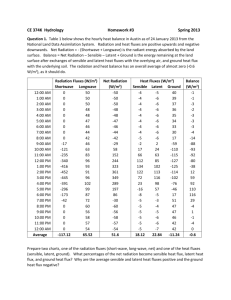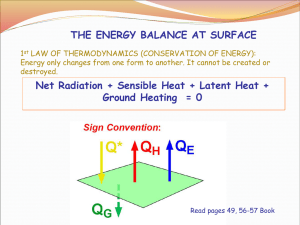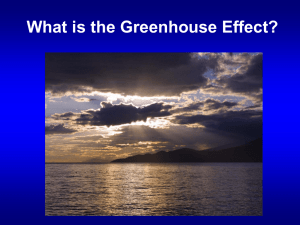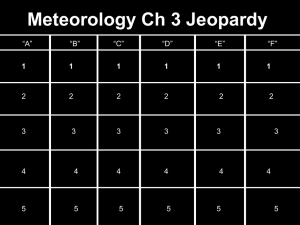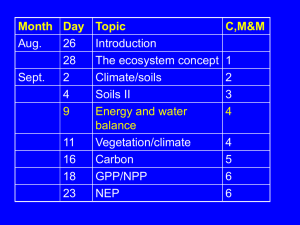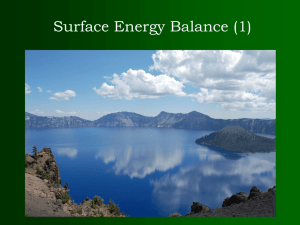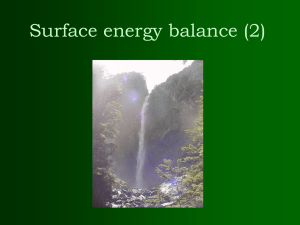1.Solar-Radiation.Energy.Temp
advertisement
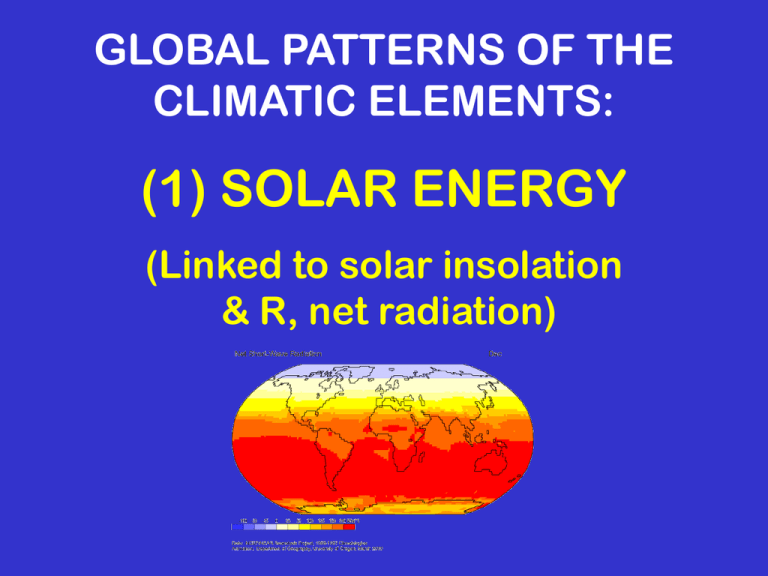
GLOBAL PATTERNS OF THE CLIMATIC ELEMENTS: (1) SOLAR ENERGY (Linked to solar insolation & R, net radiation) CONTROLS OF SOLAR INSOLATION 1) Sun angle (intensity) -- changes with latitude, time of day, time of year 2) Duration (day length) -- changes with latitude, time of year 3) Cloud cover (and general reflectivity of atmosphere) 4) Surface albedo (water, soil, snow, ice, vegetation, land use) In general, land areas (with lower atmospheric moisture) receive more insolation than adjacent water areas and the REVIEW OF INSOLATION DURATION INTENSITY RADIATION / ENERGY BALANCE Q* = ( K↓ - K↑ ) + ( L↓ - L↑ ) where K↓ = direct + diffuse shortwave solar radiation Kiehl and Trenberth (1997) BAMS Trenberth et al. (2009) BAMS Radiative Components Net short-wave radiation = short-wave down - short-wave up Net long-wave radiation = long-wave down - long-wave up Net radiation (R net) = net short-wave radiation + net long-wave radiation Positive values represent energy moving towards the surface, negative values represent energy moving away from the surface. Net short-wave radiation = Positive values represent energy moving towards the surface, negative values represent energy moving away from the surface. SW absorbed = Function of INTENSITY & DURATION & sun angle / albedo Net long-wave radiation = Positive values represent energy moving towards the surface, negative values represent energy moving away from the surface. Net Surplus Annual mean absorbed solar radiation, emitted longwave radiation (OLR) and net radiation by latitude S = Solar radiation T = Terrestrial Net Radiation = Positive values represent energy moving towards the surface, negative values represent energy moving away from the surface. Non-Radiative Components Sensible heat flux (H) = direct heating, a function of surface and air temperature Latent heat flux (LE) = energy that is stored in water vapor as it evaporates, a function of surface wetness and relative humidity Positive values for sensible and latent heat flux represent energy moving towards the atmosphere, negative values represent energy moving away from the atmosphere. Non-Radiative Components Change in heat storage (G) = net radiation - latent heat flux - sensible heat flux G = R net - LE - H Positive values for change in heat storage represent energy moving out of storage, negative values represent energy moving into storage. Sensible Heat Flux = H Positive values for sensible and latent heat flux represent energy moving towards the atmosphere, negative values represent energy moving away from the atmosphere. Latent Heat Flux = LE Positive values for sensible and latent heat flux represent energy moving towards the atmosphere, negative values represent energy moving away from the atmosphere. R net LE H Humid Tropical / Equatorial rainforest R net H Tropical desert LE Tropical wet climate Tropical wet-dry climate Tropical desert climate Grassland /steppe climate Change in Heat Storage = G Positive values for change in heat storage represent energy moving out of storage, negative values represent energy moving into storage. Air Temperature (at the surface) = T (C) Seasonal temperature variations can be explained in terms of the latitudinal & seasonal variations in the surface energy balance. The pattern of temperatures are a function of net short-wave radiation, net long-wave radiation, sensible heat flux, latent heat flux and change in heat storage. GLOBAL PATTERNS OF THE CLIMATIC ELEMENTS: (2) TEMPERATURE CONTROLS OF HORIZONTAL TEMPERATURE PATTERNS 1. Sun angle & Duration 2. Land vs. water thermal contrasts 3. Warm & Cold surface ocean currents 4. Elevation 5. Ice/Snow albedo effects 6. Prevailing atmospheric circulation 1. Sun Angle & Duration Sun angle (influences intensity of solar insolation & albedo) Duration (based on day length) - both change with latitude and time of year Leads to: zonal (east-west) distribution of isotherms, hot in low latitudes; cold in high latitudes 2. Land vs. water thermal contrasts Given the same intensity of insolation, the surface of any extensive deep body of water heats more slowly and cools more slowly than the surface of a large body of land. 4 Reasons: 1) water has a higher specific heat and heat capacity than land 2) transmission of sunlight into transparent water 3) mixing is possible in water, but not soil 4) evaporation cools air over water during hot season (less evap during winter) Leads to: • annual and diurnal temperature ranges will be less in coastal/marine locations • the lag time from maximum insolation to time of maximum temperature may be slightly longer in coastal/marine locations 3. Warm and Cold Ocean Currents 4. Elevation 5. Ice /Snow Albedo & Other Effects 6. Prevailing atmospheric circulation Temperatures are affected by the temperature "upwind" -- i.e. where the prevailing winds and air masses originate MAPPING HORIZONTAL TEMPERATURE PATTERNS •Isotherms = lines connecting points of equal temperature •Isotherms will be almost parallel, extending east-west if Control #1 (sun angle) is the primary control. •If any of the other controls are operating, isotherms on a map will have an EQUATORWARD shift over COLD surfaces and a POLEWARD shift over WARM surfaces •The TEMPERATURE GRADIENT will be greatest where there is a rapid change of temperature from one place to another (closely spaced isotherms). Continental surfaces in winter tend to have the steepest temperature gradients. Temperature gradients are much smaller over oceans, no matter what the season. JANUARY Northern Hemisphere Southern Hemisphere JULY JANUARY Northern Hemisphere Southern Hemisphere JULY http://geography.uoregon.edu/envchange/clim_animations/ Constructed by: Jacqueline J. Shinker, “JJ” Univ of Oregon Climate Lab The NCEP / NCAR REANALYSIS PROJECT DATASET http://www.cdc.noaa.gov/cdc/data.ncep.reanalysis.html The assimilated data are: -- computed by the reanalysis model at individual gridpoints -- to make gridded fields extending horizontally over the whole globe -- at 28 different levels in the atmosphere. (Some of these levels correspond to the "mandatory" pressure height level at which soundings are taken, e.g., 1000, 850, 700, 500, 250 mb, etc.) The horizontal resolution of the gridpoints is based on the T62 model resolution (T62 = "Triangular 62-waves truncation") which is a grid of 192 x 94 points, equivalent to an average horizontal resolution of a gridpoint every 210 km. The pressure level data are saved on a 2.5 latitude-longitude grid. Note that the gridpoints for computed model output are more numerous and much closer together in the mid and high latitudes, and fewer and farther apart over the low latitudes. Map of locations of Raobs soundings for the globe: Raobs = rawindsonde balloon soundings Reanalysis Output Fields The gridded output fields computed for different variables have been classified into four classes ( A, B, C, and D) depending on the relative influence (on the gridded variable) of: (1) the observational data (2) the model IMPORTANT: "the user should exercise caution in interpreting results of the reanalysis, especially for variables classified in categories B and C." (p 448) Class A = the most reliable class of variables; "analysis variable is strongly influenced by observed data" value is closest to a real observation Class A variables: mean sea level pressure, geopotential height (i.e. height of 500 mb surface, 700 mb surface, etc.), air temperature, wind (expressed as two vectors dimensions: zonal = u wind (west-east ) and meridional = v wind (north-south), vorticity (a measure of rotation) Class B = the next most reliable class of variables "although some observational data directly affect the value of the variable, the model also has a very strong influence on the output values." Class B variables: surface pressure, surface temperature (and near-surface 2-m temperature) , max and min temperature, vertical velocity, near-surface wind (u & v wind at 10 m), relative humidity, mean relative humidity, precipitable water content, and snow cover Class C = the least reliable class of variables -- NO observations directly affect the variable and it is derived solely from the model computations -- forced by the model's data assimilation process, not by any real data. Class C variables: precipitation, snow depth, soil wetness and soil temperature, surface runoff, cloud fraction (% high, middle, low), cloud forcing, skin temperature, surface wind stress, gravity wind drag, and latent and sensible heat fluxes from surface or top of the atmosphere.

